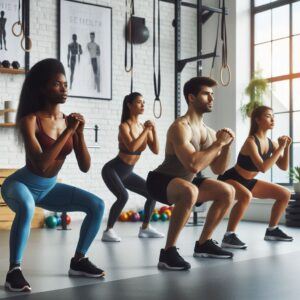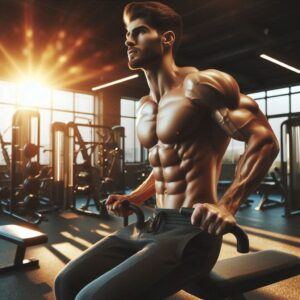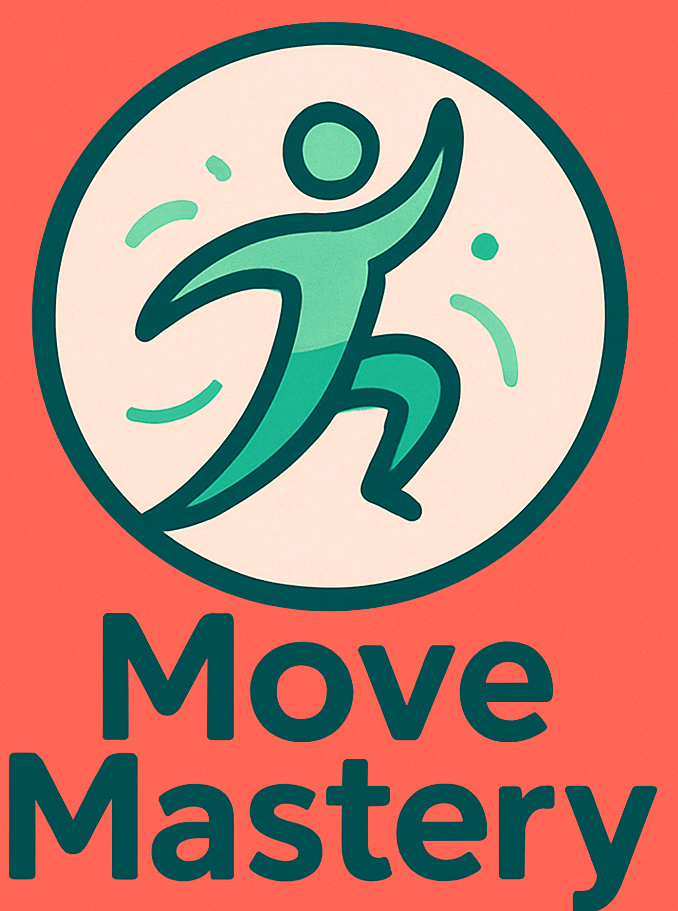 Looking for an easy way to stay fit at home? Here are 10 beginner-friendly workouts that require no equipment. They are perfect for burning fat and building strength!
Looking for an easy way to stay fit at home? Here are 10 beginner-friendly workouts that require no equipment. They are perfect for burning fat and building strength!
Want to get fit without going to the gym? You don’t need expensive equipment to build strength, burn calories, and stay in shape. These 10 beginner-friendly workouts help you achieve your fitness goals right from your home. With clear instructions and a focus on simplicity, these exercises offer convenience, cost savings, and effective ways to boost weight loss and tone your body. Let’s jump into it! Additionally, these routines come with useful tips to ensure that you benefit from every movement while keeping your safety a top priority.
1. Jumping Jacks – Full-Body Warm-Up
Jumping jacks are a great exercise to get your heart pumping and prepare your muscles for a workout. This movement serves as a full-body warm-up that activates various muscle groups while raising your heart rate.
Benefits: This exercise increases blood flow, improves coordination, and sets a positive tone for more intense movements ahead.
How to do it:
- Stand with your feet together and arms at your sides.
- Jump while spreading your legs and raising your arms above your head.
- Return to the starting position and repeat at a steady pace.
Incorporating jumping jacks in your routine for a few minutes can effectively warm up your body and prepare it for the exercises that follow. For even better results, try to keep your rhythm consistent and focus on breathing throughout the exercise to maximize its benefits.
2. Squats – Strengthening Legs and Glutes

Squats primarily target your legs and glutes, offering a fantastic way to build strength in your lower body without needing weights. They also help improve your balance and mobility.
Benefits: Squats work your quads, hamstrings, and glutes while also engaging your core. They step up mobility and contribute to overall lower body strength.
How to do it:
- Stand with your feet shoulder-width apart.
- Lower your hips back as if you were going to sit on a chair, keeping your chest upright.
- Push through your heels to return to the starting position.
Focus on maintaining proper form to avoid strain on your knees. Consistent practice can really improve muscle tone and add a boost to your leg strength. Remember to keep your back straight and your movements controlled.
3. Push-Ups – Building Upper Body and Core Strength
Push-ups are a timeless workout that target your chest, arms, and core. They can be modified to suit your strength level, making them ideal for beginners.
Benefits: Push-ups improve upper body strength, stabilize your core, and can be performed anywhere. They act as a compound exercise that works multiple muscles simultaneously.
How to do it:
- Place your hands on the floor, shoulder-width apart.
- Keep your body in a straight line from head to toe.
- Lower your chest to the floor and push back up to the starting position.
If traditional push-ups are too challenging at first, start with knee push-ups until you build sufficient strength. Get involved with your core by ensuring that each motion is deliberate and maintains proper body alignment, helping to build up your stability over time.
4. Plank – Core Stability and Endurance
The plank is a static hold exercise that targets your core muscles and helps improve overall stability. It keeps your body aligned while strengthening your midsection.
Benefits: Planks deepen core strength, bolster posture, and reduce the likelihood of back pain through improved muscle tone.
How to do it:
- Position yourself on your elbows and toes, keeping your body straight.
- Get involved with your core and hold this position for 30-60 seconds.
- Focus on keeping your hips level and your head in a neutral position.
Regular planks help build a strong core while also increasing your overall endurance and balance. As you progress, you can slowly extend the duration of your hold to further challenge your strength and control.
5. Lunges – Boosting Leg Strength and Balance
Lunges target your quadriceps, hamstrings, and glutes while giving a boost to your balance and coordination. They simulate natural movements and prepare you for daily activities.
Benefits: Lunges improve balance, strengthen your legs, and promote stability. They help develop muscle endurance and work each leg independently.
How to do it:
- Stand upright and take a step forward with one leg.
- Lower your torso until your front knee reaches a 90-degree angle.
- Push back up and repeat on the opposite side.
For added challenge, you might try holding a slight pause at the bottom of each lunge. This helps in building strength and control over your movements, making it a really important addition to your workout regimen.
6. High Knees – Quick Cardio and Calorie Burner

High knees are an energetic cardio workout that involves running in place while lifting your knees high. This exercise is effective for elevating your heart rate and burning calories.
Benefits: High knees boost cardiovascular health, step up coordination, and help burn calories quickly.
How to do it:
- Stand tall and begin running in place.
- Lift your knees to waist level at a controlled yet brisk pace.
- Focus on maintaining a quick rhythm while ensuring proper posture.
This exercise works wonders for cardio bursts and is ideal for inclusion in high-intensity interval training. Consistently practicing high knees can also help improve agility and stamina throughout your daily activities.
7. Bicycle Crunches – Targeting the Abdominals
Bicycle crunches are an effective exercise for engaging and strengthening your abdominal muscles. They target both the upper and lower abs along with your obliques.
Benefits: This exercise tones your abs, improves core strength, and supports spinal stability.
How to do it:
- Lie on your back with your knees bent.
- Place your hands behind your head and lift your shoulders off the floor.
- Alternate touching your elbow to the opposite knee while cycling your legs in the air.
Maintain a steady pace and get involved with your core throughout the movement. These crunches help reinforce a strong midsection, which is essential for overall balance and back support.
8. Triceps Dips – Strengthening Arms and Shoulders

Triceps dips can be performed using a sturdy chair or low table at home. They focus on building strength in your triceps while also working your shoulder muscles.
Benefits: This exercise tones the back of your arms and shoulders while engaging your core to stabilize your body during the movement.
How to do it:
- Position your hands on the edge of a stable chair with your fingers facing forward.
- Extend your legs and slowly lower your body until your elbows form a 90-degree angle.
- Push yourself back up to the starting position.
Triceps dips are really important for developing arm strength and stability. They can be modified by bending your knees, making them accessible for beginners and a great stepping stone for eventual progression.
9. Wall Sit – Building Lower Body Stamina
The wall sit is a static exercise that challenges the strength and endurance of your leg muscles. It requires minimal movement but a great deal of control and stability.
Benefits: Wall sits build endurance in your quadriceps, boost leg strength, and are excellent for developing stability.
How to do it:
- Stand with your back against a wall and slide down until your knees are at a 90-degree angle.
- Hold this position for as long as you can, aiming for 30 seconds to one minute at a time.
- Keep your core engaged and your back flat against the wall throughout the duration.
Even though this exercise may seem simple, adding regular wall sits to your routine can significantly improve your lower body endurance. Over time, you might find that your stamina not only increases but that your overall posture and leg control reach new heights.
10. Burpees – The Ultimate Full-Body Fat Burner
Burpees combine strength training and cardio into one challenging exercise. They use multiple muscle groups and provide a robust workout session.
Benefits: Burpees build strength, improve endurance, and blast calories in a short period. They’re excellent for boosting overall fitness levels.
How to do it:
- Start in a standing position, then drop into a squat position.
- Kick your feet back into a push-up position and perform a push-up.
- Quickly return your feet to the squat position and explosively jump up.
While burpees are a more intense exercise, performing them at a beginner pace helps acclimate your body to this demanding move. As your strength and endurance improve, you can work on increasing speed and intensity to further challenge yourself.
Bonus: Sample 7-Day Home Workout Plan for Beginners
This simple weekly plan mixes the exercises above to ensure you get a well-rounded workout routine without any equipment. The plan is designed to offer variety and gradually build strength, flexibility, and endurance.
Day 1: Warm up with 3 minutes of jumping jacks, perform 2 sets of 15 squats, 2 sets of 10 push-ups, and finish with a 30-second plank. End with a 30-second wall sit. This combination helps set a solid foundation for the week.
Day 2: Focus on cardio with 3 rounds of high knees (40 seconds each) with 20 seconds of rest between rounds. Follow with 2 sets of 15 lunges on each leg to increase lower body strength.
Day 3: Work your core with 2 sets of 20 bicycle crunches, a 45-second plank, and add 10 triceps dips using a chair. This day helps sharpen your midsection.
Day 4: Take it easy with a light active recovery day. Opt for a brisk walk or a gentle stretching session so that your muscles can recover and prepare for the next workout.
Day 5: Combine the routines: 3 minutes of jumping jacks, 2 sets of squats, 2 sets of push-ups, 20 high knees, and a 30-second wall sit. This mix challenges multiple muscle groups in one session.
Day 6: Challenge your endurance with 2 rounds of burpees (aim for 8-10 per round), followed by 2 sets of lunges on each leg and a 60-second plank. This robust session is perfect for testing your progress.
Day 7: Use this day for active recovery. Focus on stretching, mobility work, and a gentle walk to ensure your muscles are well-rested and your body is ready for another week of workouts. This day is about easing into recovery and reflecting on your progress.
The plan is flexible and can be adjusted depending on your fitness level. It’s designed to introduce variety and gradual progression so that you steadily build up strength and endurance in a sustainable way.
Want to increase resistance for even better workout results, Check out my post on top home workout equipment. GO HERE
FAQ
❓ How many times a week should I do these workouts?
💡 If you’re a beginner, start with 3-4 workouts per week, allowing your muscles time to recover. As you get stronger, you can increase to 5-6 days per week with variety in intensity.
❓ Can I lose weight with home workouts?
💡 Yes! Home workouts can be highly effective for weight loss when combined with a healthy diet and consistency. Add cardio-based exercises like jumping jacks, burpees, and high knees to burn calories faster.
❓ How long should each workout session be?
💡 A 20-30 minute session is enough for beginners. The key is to stay consistent and focus on good form over intensity.
❓ Do I need a warm-up and cool-down?
💡 Absolutely! A 5-minute warm-up (e.g., arm circles, jumping jacks) prevents injuries, and a cool-down (e.g., stretching) helps with recovery and flexibility.
Wrapping Up Your Home Workout Adventure
These 10 simple workouts prove that you don’t need a gym membership or fancy equipment to stay fit. They incorporate full-body routines that build strength, improve balance, step up endurance, and burn calories. With clear benefits and step-by-step instructions, each exercise forms a building block in your overall fitness adventure.
It’s about finding joy in movement. It’s about committing to regular exercise. Whether you choose to start your day with a burst of jumping jacks or wind down with a steady wall sit, you are taking meaningful steps toward a healthier lifestyle.
•Which exercise will you try first? I’d love to hear about your progress and experiences. Feel free to share this plan with a friend who might be looking for a simple way to get started with home workouts.
Remember that consistency is very important. Keep challenging yourself, adapt your routine as needed, and enjoy every moment of your workout adventure. Your journey to improved health is filled with small victories that add up to incredible overall progress.
Now that you have the best home workouts, make sure you’re eating right! Check out my post on The Best Post-Workout Meals for Muscle Recovery HERE
